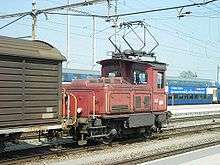Shunting (rail)
Shunting, in railway operations, is the process of sorting items of rolling stock into complete train sets or consists, or the reverse. In the United States this is known as "switching".
Motive power
Motive power is normally provided by a locomotive known as a shunter in the UK or as a switcher in the USA. Most shunter/switchers are now diesel-powered but steam and even electric locomotives have been used. Where locomotives could not be used (e.g. because of weight restrictions) shunting has been done by horses or capstans.
 A heavy steam shunting locomotive, SR Z class, Great Britain
A heavy steam shunting locomotive, SR Z class, Great Britain Light dual-mode (electric and diesel) shunter SBB Tem 346 at work on the Swiss Federal Railways.
Light dual-mode (electric and diesel) shunter SBB Tem 346 at work on the Swiss Federal Railways. Railway shunting capstan found at site of former Hull and Barnsley Railway sidings south of Springhead works.
Railway shunting capstan found at site of former Hull and Barnsley Railway sidings south of Springhead works..jpg) A CIE 141 Class shunting the Enterprise rolling stock to enable a NIR Class 111 to haul a service from Dublin Connolly to Belfast Central in 1985.
A CIE 141 Class shunting the Enterprise rolling stock to enable a NIR Class 111 to haul a service from Dublin Connolly to Belfast Central in 1985.
Hazards
The occupation of shunter/switcher is particularly dangerous because not only is there the risk of being run over, but on some railway systems—particularly ones that use hook-and-chain coupling systems—the shunters have to get between the wagons/carriages in order to complete the coupling and uncoupling. This was particularly so in the past. The Midland Railway company, for example, kept an ambulance wagon permanently stationed at Toton Yard to give treatment to injured shunters.
The main tool of shunters working with hook-and-chain couplings was a shunting pole, which allowed the shunter to reach between wagons to fasten and unfasten couplings without having physically to go between the vehicles.
See also
- Marshalling (UK) or classification (US) yard
- Shunter (UK) or switcher (US)
- Switching and terminal railroad
Further reading
- Bostel, Nathalie, and Pierre Dejax. "Models and algorithms for container allocation problems on trains in a rapid transshipment shunting yard." Transportation science 32.4 (1998): 370-379.
- Boysen, Nils, et al. "Shunting yard operations: Theoretical aspects and applications." European Journal of Operational Research 220.1 (2012): 1-14.